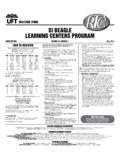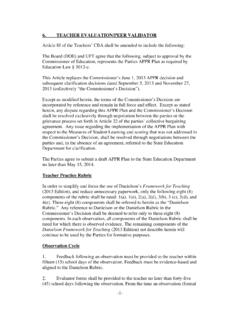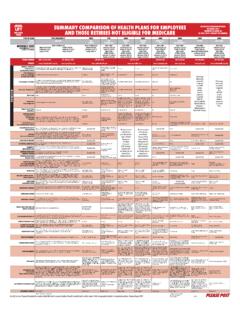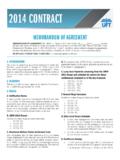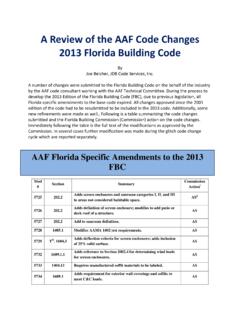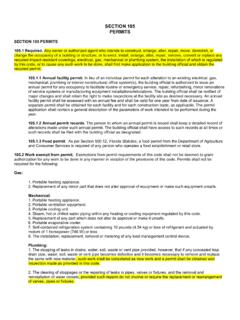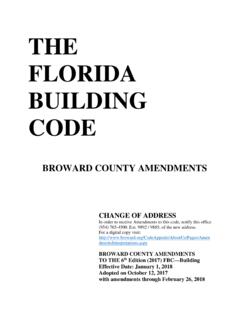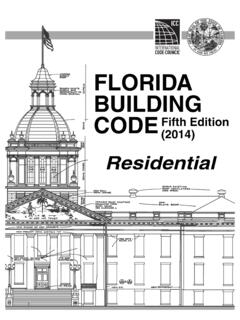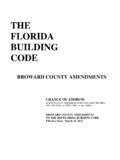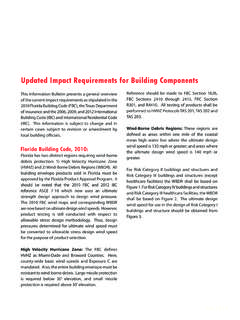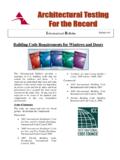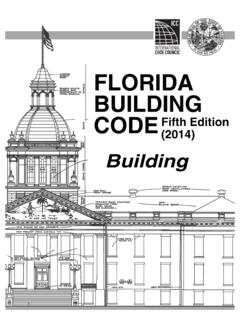Transcription of Occupancy Net Floor Area per Occupant (sq. ft.)
1 TABLE 6-2 Occupant LOAD REQUIREMENTS NET area TABLE Occupancy Net Floor area per Occupant (sq. ft.) Billiard 50 Bowling 50 20 Dance 10 Dining spaces (nonresidential).. 12 Exhibition 10 Garages and open parking 250 15 Habitable 140 Industrial 200 In 30 Institutional sleeping rooms 75 Children (except as listed below).. 50 Day Care a. under 6 50 b. 6 mos. * 2 40 c. 2 yrs. * 6 30 Institutional staff, 30 35 Kitchens (nonresidential).. 200 50 Preparation 100 25 Locker 12 100 Passenger terminals or Sales areas (retail) 1st Floor or 25 All other 50 Seating areas (audience) in all places of assembly Fixed D Moveable 10 Skating 15 Stages (See subchapter eight).
2 Standing room (audience) in all places of 4 Storage 200 Notes: C capacity of all passenger vehicles that can be unloaded simultaneously. D designed number of seats or occupants. *Dash not enacted but probably intended revision: October 1, 2004 [ ] 27-358 Occupant load. - The number of occupants for whom exit facilities shall be provided shall be established either (1) by the actual number of occupants for whom each occupied space, Floor , or building, as the case may be, is designed, or (2) by using the appropriate Occupant - area ratios from table 6-2, whichever is larger. The Occupant load of any space shall include the Occupant load of all spaces that discharge through it in order to gain access to an exit.
3 (a) Unlisted occupancies. - Where data regarding the sq. ft. per person for an Occupancy is not listed in table 6-2, the Occupant load shall be established by an architect or engineer, subject to the approval of the commissioner. (b) Modifications. - (1) When the actual Occupant load of any space will be significantly lower than that listed in table 6-2, the commissioner may establish a lower basis for the determination of the Occupant load. (2). When a building existing on December sixth, nineteen hundred sixty-eight is altered or changed in Occupancy or use so as to require enlarged exit facilities, the commissioner may authorize the alteration or change in Occupancy or use without an enlargement of exit facilities, provided the Occupant load is limited to that accommodated by the existing exit facilities as determined by the provisions of this code, and the building or space is posted accordingly with a sign.
4 Such signs shall be at least twelve inches in width and sixteen inches in height. The lettering shall be red on a white background. The letters shall be not less than one inch high and the numerals not less than one and one quarter inches high. (c) Non simultaneous Occupancy . - The Occupant load of toilets, locker rooms, meeting rooms, storage rooms, employee cafeterias, and similar rooms or spaces that are not occupied at the same time as other rooms or spaces on the same Floor of a building, may be omitted from the Occupant load calculation of the Floor on which they are located to the extent that such spaces serve occupied rooms on the same Floor . [ ] 27-360 Travel distance.
5 (a) General requirement. -The maximum travel distance from the most remote point in any room or space to the center of a door opening directly on an open exterior space, a vertical exit, an interior stair, an exit passageway or to a horizontal exit shall not be greater than the limit specified in table 6-1 for the Occupancy group classification of the room or space

